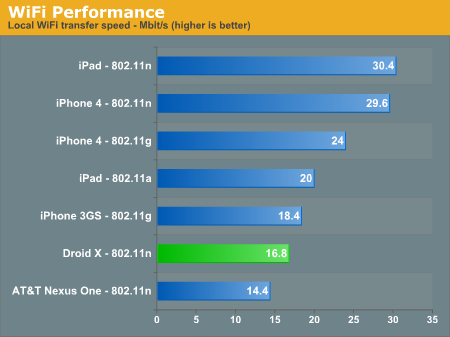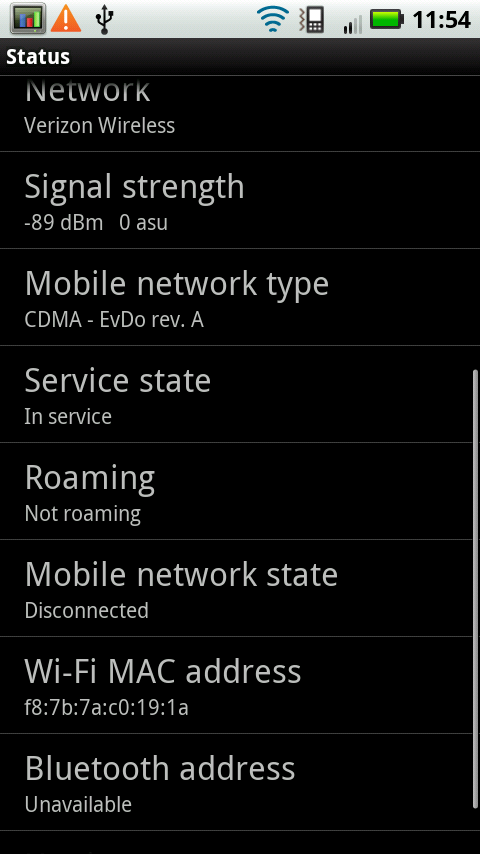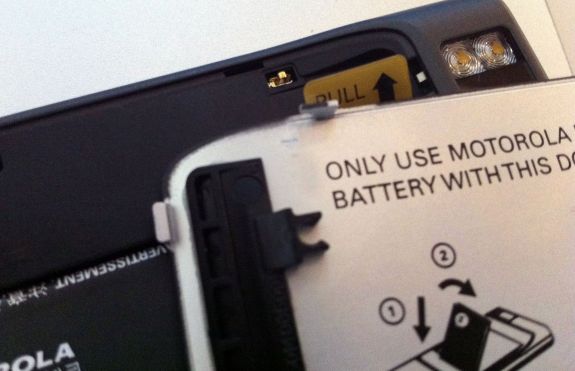Motorola Droid X: Thoroughly Reviewed
by Brian Klug on July 20, 2010 4:27 PM EST- Posted in
- Smartphones
- Motorola Droid X
- OMAP
- Mobile
Connectivity
The X supports CDMA 800/1900 and Ev-DO Revision A for data. There’s also Bluetooth 2.1+EDR, and WiFi 802.11g/n. I did notice N working at 72 megabits/s which seems to be the standard negotiated N connection speed for smartphones lately.
I’m somewhat of a speedtest freak, and I’ve run just shy of 100 speedtests on the X over cellular data. My average downstream speed has come to 0.91 megabits/s, upload is 0.73 megabits/s. This is completely on par with what I’d expect from CDMA 200 Ev-DO Rev.A networks. Though it isn’t anything special, I give the X credit for performing up to par, especially considering the number of... erm... devices that are shipping with some variety of radio problem.
Unfortunately, I did experience a lot of disconnections when connecting to N wireless networks. Searching online, a lot of people seem to be experiencing the same issue. Initially this posed a big problem for our WiFi page loading battery life benchmark, as I had to keep checking every 10 minutes to see if the phone was still connected. Later, I tried connecting to my WRT54G-TM running tomato (802.11g) and completed the test with a solid connection.
Later, I ran my WiFi throughput tests and noticed that the connection would drop on 802.11n whenever throughput started to go very fast, as it approached real N rates on my network. I switched back and forth between a WRT600N and latest generation Airport Extreme - both elicited the same behavior. The connection would drop, and sometimes not resume until I manually turned WiFi off and back on. This is very similar to some of the connectivity issues I’ve experienced with immature 802.11n stacks on the desktop, or due to chipset incompatibilities. Connecting to 802.11g, I was able to hold a solid connection without trouble.
Clearly the problem seems to be with the WiFi stack when connected to 802.11n networks. Hopefully this will be corrected in the future with some software update. There were rumors that this would be fixed with the July 19th update to 1.13.604 - it seems that review units were pushed this update a week early, as I saw it a while ago. WiFi still drops and reconnects periodically even running this version of the software and baseband.
Throughput on the X while downloading a 100 MB PDF stored locally was 16.8 megabits/s.

I also noticed that the X has longer wireless range than the EVO. I’ve been asked in the past to test wireless range - the X, Nexus One, and iPhone 4 I had on hand all kept stable WiFi connections to roughly the same distance.
Cellular Antennas
There’s also been a bit of discussion lately about the X’s diversity antenna configuration. If nothing else, the iPhone 4 antenna controversy has drawn attention to the fact that attenuation due to the composition of your hand happens on all devices.

Getting signal strength in dBm on Android is as easy as about -> status. Or a documented dialer code.
So how does the X fare? I saw a worst case drop of 15 dB on the X, cupping it tightly death grip style. I had an original Droid side by side and saw the same signal (-89 dBm at my house), so reception without holding the phone is unscientifically the same. The X drops signal about the same amount of signal due to attenuation from your hand being in the way as every other smartphone with an internal antenna. 15 dB is completely typical.
| Signal Attenuation Comparison in dB - Lower is Better | |||||||
| Cupping Tightly | Holding Naturally | On an Open Palm | Holding Naturally Inside Case | ||||
| Droid X | 15.0 | 5.1 | 4.5 | NA | |||
| iPhone 4 | 24.6 | 19.8 | 9.2 | 7.2 | |||
| iPhone 3GS | 14.3 | 1.9 | 0.2 | 3.2 | |||
| HTC Nexus One | 17.7 | 10.7 | 6.7 | 7.7 | |||
I’m not entirely sure what’s going on with the X’s spatially diverse antennas - I could make signal drop when holding the bottom of the phone, which is standard placement area for smartphone antennas these days, yet no drop happened when I cupped the top half tightly. I’m not saying definitively that there isn’t spatial diversity for the cellular antenna, just that I could never see evidence of it in the numbers. Perhaps Motorola is doing something much more subtle, or the value being reported in Field Trial is only for the bottom antenna - it’s entirely possible that the reporting I saw in the Field Trial and About -> Status doesn't reflect what the baseband is seeing.
I noticed something else curious and briefly made mention of it before. On the back of the phone under the battery door, there’s a gold contact that makes contact with the battery door. There are also three metal connectors that make contact with the tabs that lock the door in place.
Is the X pulling an iPhone 4 with creative antenna design? It seems possible, though I’m not sure what it’s being used for. WiFi signal strength is the same with the battery door on and off, as is cellular, and GPS. It also isn’t being used to tell if the door is on or not, as the device works the same with it on or off. Perhaps this is just for grounding.











89 Comments
View All Comments
TareX - Thursday, July 22, 2010 - link
Why are all the Samsung Galaxy S phones missing from your charts and comparisons? I wanted to see how Hummingbird compared and how the Super AMOLED fared against their Droid X counterparts...strikeback03 - Tuesday, July 27, 2010 - link
Maybe because the first US version launched a day before the review went up, and they weren't sent a review sample.enealDC - Thursday, July 22, 2010 - link
Great job!Juniper Research - Friday, July 23, 2010 - link
Very interesting article... we have this week published a new report on smartphones and a free whitepaper is available to download here... http://www.juniperresearch.com/reports/next_genera...John Levett
Marketing Executive at Juniper Research
Homefries - Saturday, July 24, 2010 - link
First off, great review Brian.However, while you did a very thorough comparison of the Droid X to other Android devices, you barely mentioned the real competitor the Droid X has to stand up against: the iPhone 4.
Readers want to know if the Droid X is the best phone on the market - the whole market - not just the market subset dedicated to Android devices.
Like the majority of the tech media, your review furthers the notion readers belong exclusively to either the iOS camp or the Andriod camp. This is simply not true. Informed readers, like the ones that peruse Anandtech, want to buy one smartphone, regardless of any marketing slants, that is the best.
Your review of the Droid X should have helped us answer the question, "Should I buy the Droid X or the iPhone 4?" But, it did not.
strikeback03 - Tuesday, July 27, 2010 - link
Well, I think the conclusion in the iPhone article and some earlier Android articles applies, there is no "best" for everyone. Some people love Apple and the Apple way of life, some people won't touch it. As the iPhone is currently limited to AT&T, that is going to deter a lot of people. How large a pocket/bag you plan on carrying the phone in might make size differences more important to some than others. So while I am not one of the readers calling for no subjective opinions (it is interesting that FroYo feels significantly faster/different) I think it is still up to each buyer to decide what is most important to them.Electrofreak - Saturday, July 24, 2010 - link
Brian and Anand, are you sure you're using the correct information regarding the SoC in the Droid X? I believe it is a OMAP 3640, not a 3630, as the maximum recommended clock speed of the 3630 is described in numerous places across the net as being 720 MHz, while the max clock speed of the 3640 is described as 1 GHz. In addition, the max recommended clock speed of the 3430 in the Droid was 600 MHz, not 800.The information I cite above is widely available across the web... if you've got inside information the rest of us don't have, by all means let us know. But as someone who has written articles of my own on ARM SoCs and follows ARM industry news closely, I suspect that your data may not be 100% correct.
Regardless, I do have to thank you for writing some of the most informative hardware articles on the net. I appreciate it!
Electrofreak - Saturday, July 24, 2010 - link
...and I just found this: http://e2e.ti.com/blogs_/b/mobile_momentum/archive...So, per TI's blog it is the 3630... now we just need an explanation of the other info on the web that describes the 3630 as maxing out at 720 MHz.
Brian Klug - Monday, July 26, 2010 - link
Yeah, TI's documentation is a bit outdated. Anand tackled the SoC part, but the 3630 is indeed a 1 GHz part, it isn't the 3640 guaranteed. There was a lot of confusion online about it, but Anand got the official word. ;)I agree, back when I did my other OMAP 3 piece it was 720 MHz.
-Brian
Electrofreak - Saturday, July 24, 2010 - link
Looking forward to that Hummingbird review Brian. I hope you're able to dig up some info that I wasn't able to when I wrote my article (http://alienbabeltech.com/main/?p=17125) back in April.